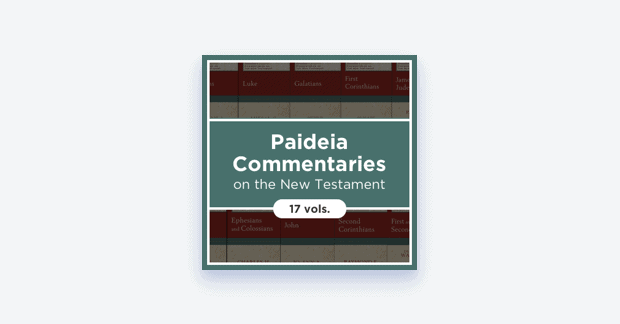Breeze through the Paideia commentary series description and you might miss its distinguishing mark:
The Paideia: Commentaries on the New Testament approaches each text in its final, canonical form, proceeding by sense units (pericopes) rather than word by word or verse by verse. Thus, each commentary follows the original train of thought as indicated by the author instead of modern artificial distinctions. (Emphasis mine)
Artificial distinctions . . . ouch. Is the Paideia throwing shade on other commentaries?
Not necessarily. Few serious scholars, if any, would argue that the verse numbers are anything but a helpful referencing and organizing tool. It’s well-known that verse numbers are “artificial” to the Bible; they didn’t appear consistently until the late 1500s.
That said, Bibles without verse markers are making a resurgence, as readers find that the literary flow comes through clearer without them.
Seeing as the point of a commentary is to help exegetes access the narrative flow—broadly and in detail—it makes sense that Paideia chooses to ditch artificial divisions and focus on the inherent organization.
(In support of other commentaries, though: Most discuss high-level organization before moving into verse-by-verse commentary. Plus, every commentary has its strengths. Nothing is going to help you settle minute interpretive challenges like critical commentaries.)
But back to the Paideia, how does it actually execute on this?
Inside the commentary
Here’s a snapshot from part of the Matthew Commentary. As you’ll see, the emphasis is on structure and organization. If you were to continue reading, you would see that the commentary does dip a bit into verse-level commentary, but that is not the principle organization, nor does it treat every verse individually.
Snapshot:
Introductory Matters
What sets Matthew 3:1–4:17 off as a distinct unit? Its principle of organization. This segment of narrative is held together by an inclusio beginning at 3:2 (John says, “Repent for the kingdom of heaven is at hand”) and ending at 4:17 (Jesus says, “Repent for the kingdom of heaven is at hand”). The unit is, moreover, arranged in a chiastic pattern, ABCDED′C′B′A′. In outline form it looks like this:
A John the Baptist preaches, “Repent for the kingdom is at hand” (3:1–2)
B John fulfills the Scriptures (3:3; cf. Isa. 40:3)
C John is Elijah (3:4; cf. Matt. 11:14; 17:12–13; cf. also 2 Kings 1:8)
D Various responses to John’s baptism and John’s responses to them, first positive (vv. 5–6) and then negative (vv. 7–10) (3:5–10)
E John compares himself with the Mightier One. John is the lesser (3:11–12)
D′ Jesus’s response to John’s baptism and John’s response to him (3:13–17)
C′ Jesus is the son of God, who reverses Israel’s failures in the wilderness (i.e., hunger [cf. Exod. 16]; testing God [cf. Exod. 17]; and idolatry [cf. Exod. 32]) (4:1–11)
B′ Jesus fulfills the Scriptures (4:12–16; cf. Isa. 9:1–2)
A′ Jesus preaches, “Repent, for the kingdom is at hand” (4:17)
The flow within the pattern focuses first on John separately, then on the Baptist’s relation to Jesus, and finally primarily on Jesus. We will read the text in terms of this chiastic pattern, but since some of the John sections of the chiastic structure are quite brief and some of the Jesus sections much longer, not all elements in the chiasm are on the same level in the accompanying outline.
***
By far the bulk of the commentary is on the narrative arc of Matthew. It reads somewhat like a literary analysis, mixing considerations of theme, structure, genre, and outside commentary.
Behind the name
If you’re like most readers, you don’t know that “Paideia” means “education and upbringing.” Why did the editors and publisher choose this name? In their own words:
The name “Paideia” reflects (1) the instructional aim of the series—giving contemporary students a basic grounding in academic New Testament studies by guiding their engagement with New Testament texts; (2) the fact that the New Testament texts as literary unities are shaped by the educational categories and ideas (rhetorical, narratological, etc.) of their ancient writers and readers; and (3) the pedagogical aims of the texts themselves—their central aim being not simply to impart information but to form the theological convictions and moral habits of their readers.
Each commentary deals with the text in terms of larger rhetorical units; these are not verse-by-verse commentaries. This series thus stands within the stream of recent commentaries that attend to the final form of the text. Such reader-centered literary approaches are inherently more accessible to liberal arts students without extensive linguistic and historical-critical preparation than older exegetical approaches, but within the reader-centered world the sanest practitioners have paid careful attention to the extratext of the original readers, including not only these readers’ knowledge of the geography, history, and other context elements reflected in the text but also their ability to respond correctly to the literary and rhetorical conventions used in the text. Paideia commentaries pay deliberate attention to this extratextual repertoire in order to highlight the ways in which the text is designed to persuade and move its readers. Each rhetorical unit is explored from three angles: (1) introductory matters; (2) tracing the train of thought or narrative or rhetorical flow of the argument; and (3) theological issues raised by the text that are of interest to the contemporary Christian. Thus, the primary focus remains on the text and not its historical context or its interpretation in the secondary literature.
Add the Paideia commentary series to your Logos library now.





